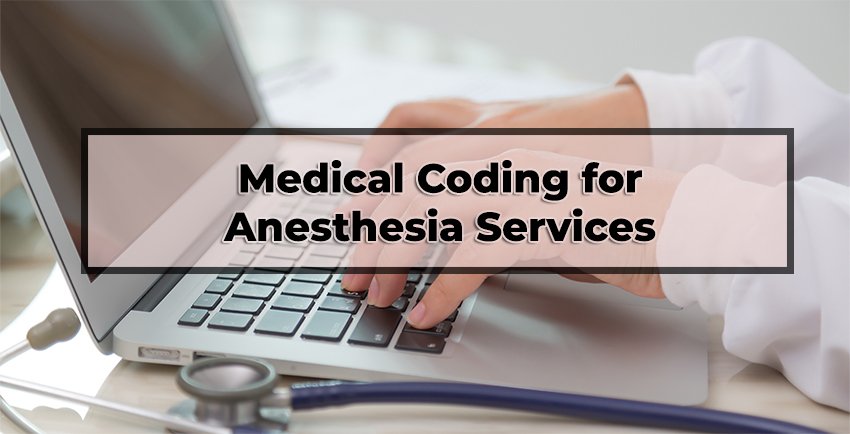Medical Coding for Anesthesia Services
Anesthesia coding is a specialized area of medical coding that requires detailed knowledge of the type of anesthesia administered, the surgical procedure, the patient’s condition, and any additional services provided during anesthesia care. Anesthesiologists or certified registered nurse anesthetists (CRNAs) provide anesthesia services for surgeries, labor and delivery, diagnostic procedures, and pain management. Coders use CPT (Current Procedural Terminology) codes to reflect anesthesia services, ICD-10-CM codes for diagnoses, and HCPCS codes for drugs or supplies used in anesthesia administration.

Key Elements of Anesthesia Coding
- Understanding Anesthesia Codes and Surgical Procedures: Anesthesia codes are unique because they are linked to the surgical procedure or service being performed. Each anesthesia code is associated with a corresponding surgery, such as 00100 for anesthesia during a procedure on the head or 00840 for anesthesia during lower GI procedures. Coders must match the anesthesia code with the correct surgical CPT code to ensure accurate billing.
- Base Units, Time Units, and Modifying Factors: Anesthesia coding is based on a formula that includes base units (reflecting the complexity of the procedure), time units (the duration of anesthesia), and modifying factors (additional considerations like the patient’s condition or special services). The base unit values are assigned to each anesthesia code and represent the relative difficulty of the service. Time units are calculated based on the total duration of anesthesia administration, typically in 15-minute increments. Additional factors, such as physical status modifiers (e.g., P1-P5), are used to represent the patient’s health status, and other modifiers indicate special conditions or procedures.
- Anesthesia Modifiers and Concurrency Rules: Proper use of modifiers is essential for anesthesia coding. For example, modifier -AA represents anesthesia services personally performed by an anesthesiologist, while modifier -QX indicates anesthesia provided by a CRNA with medical direction. Concurrency rules are also important, as they limit the number of anesthesia cases that can be performed simultaneously by a single provider. Coders must understand these rules to ensure that services are billed correctly according to regulatory guidelines.
Special Considerations in Anesthesia Coding
- Calculating Total Anesthesia Time Accurately: One of the critical aspects of anesthesia coding is the accurate calculation of time units. Anesthesia time starts when the anesthesiologist or CRNA begins preparing the patient for anesthesia and ends when the patient is safely placed under post-anesthesia care. Coders must track every minute of anesthesia to ensure that the time reported on the claim is precise and reflective of the service provided.
- Coding for Monitored Anesthesia Care (MAC) and Regional Anesthesia: Different types of anesthesia require specific codes and modifiers. For instance, Monitored Anesthesia Care (MAC) involves monitoring the patient’s vital signs and adjusting sedation levels as needed, typically coded with modifier -QS. Regional anesthesia, such as epidural or spinal anesthesia, is coded separately based on the procedure and the area anesthetized. Coders must document the type of anesthesia provided, as well as any conversions from one form to another during the procedure.
- ICD-10-CM Coding for Anesthesia-Related Conditions: Alongside procedural codes, diagnosis codes are crucial for representing the patient’s underlying condition and any comorbidities that may impact anesthesia. For example, coding for anesthesia services during a procedure on a patient with diabetes would require additional ICD-10-CM codes to reflect the diabetes diagnosis and any related complications, ensuring that the full clinical picture is accurately captured.
Challenges in Anesthesia Coding
- Navigating Complex Surgical Procedures and Their Anesthesia Codes: Coders face challenges in accurately selecting the correct anesthesia codes for complex or multiple procedures performed during the same session. For example, when multiple surgeries are performed simultaneously, coders must determine which anesthesia code is the primary service and how additional time should be allocated to each procedure.
- Applying Modifiers and Special Billing Requirements: The use of modifiers is common in anesthesia coding, especially in cases involving special circumstances like emergency services, trauma, or patients with significant comorbidities. Coders must be aware of the specific billing rules for each modifier, including how they affect payment rates, compliance with payer policies, and documentation requirements.
Best Practices for Accurate Anesthesia Coding
- Detailed Documentation of Services and Time: Anesthesiologists and CRNAs should document the start and stop times for anesthesia, the type of anesthesia administered, any medications or techniques used, and the patient’s response. Coders use this documentation to calculate time units, apply the correct modifiers, and ensure accurate billing.
- Staying Updated with Anesthesia Coding Changes and Guidelines: Anesthesia coding guidelines are subject to updates, and coders must stay informed about changes to CPT codes, base unit values, and billing rules. This is particularly important for ensuring compliance with payer policies and regulatory standards.
Medical coding for anesthesia services is a detailed and intricate process that requires careful consideration of the type of anesthesia provided, the surgical procedure, the patient’s condition, and the duration of services. Coders must accurately calculate time units, apply modifiers, and use the correct anesthesia codes to ensure proper billing and reimbursement. Staying updated on anesthesia coding rules and payer-specific guidelines is essential for supporting the comprehensive care provided by anesthesia professionals and ensuring successful claims processing.

